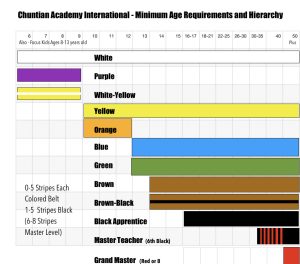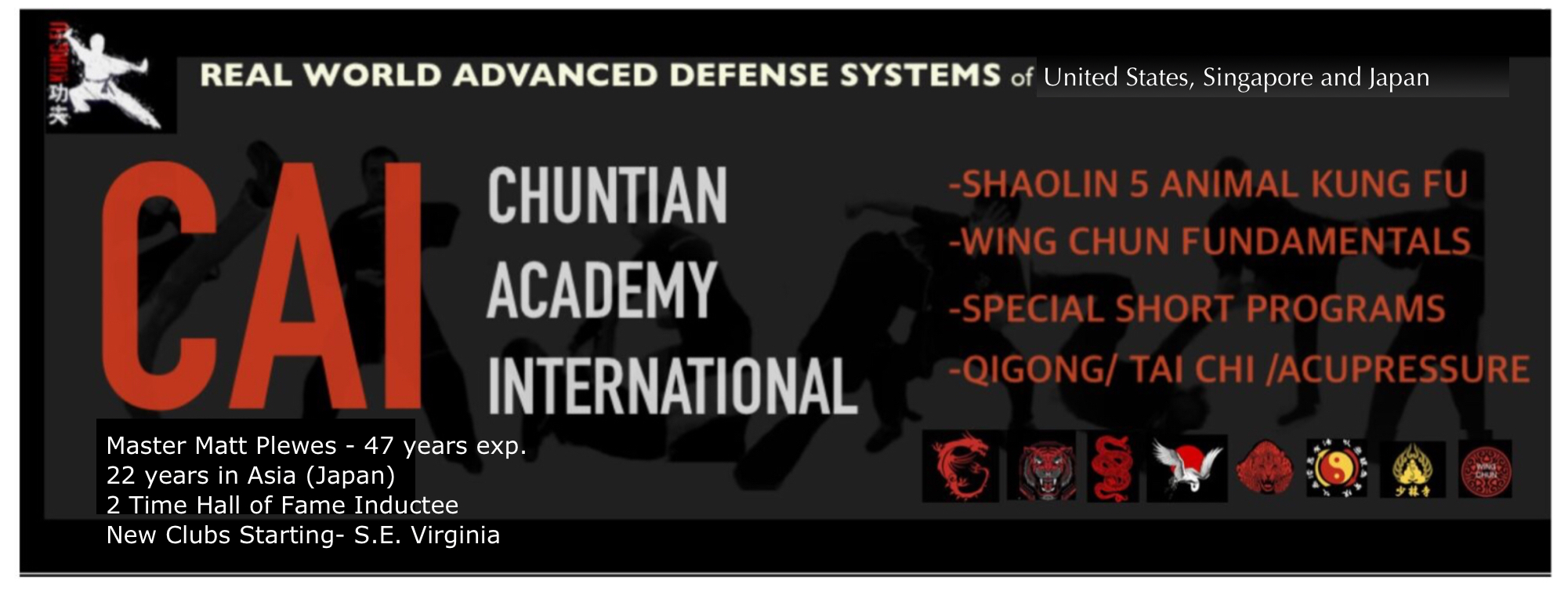Matthew Plewes, 47 year practitioner of real-world defense. 1976-1982 Seikukan Karate-do under Master Terumasa Ogawa, 1982-1985 Fundamental Wing Chun and JKD 1995-97, (Art Wong), 1984 to 2000 Five Animal Kung fu and Chin’na under Samuel Cheeks, (Received Jr. Instructor after 5 years and Master Teacher Certification after 17 years. From 1996-1999 Yang Style Tai Chi Chuan and Qigong under Master Li Sun, member of Shanghai Tai Chi Association. From 2001 to present residing in Japan teaching, researching fighting tactics of non-sport Asian martial arts.
About: Based in Shizuoka, Japan for 22 years, American Matt Plewes has more than 46 years in martial arts study. Matt’s training was under real masters, years of diligent practicing and researching, and now teaching.
A total of 25 years in America and 22 years in Asia (Japan). Matt is currently back in America.
Matt founded Chuntian Academy in 1985 as a senior student under the supervision of his Master-teacher Samuel Cheeks.
Training – CAI-Defense-focused techniques are scientific research on self-defense. Its self-defense focuses on reflexes and natural body movements that do not require power and aims to avoid violence instantly. This stems from ancient martial arts techniques and functional police and military techniques suitable for the modern world.
CAI’s defense program teaches practical ways to prevent all violence and attacks. For that technique, it is important to enter a battle posture and train under conditions that are close to the actual scenario. With unique and comprehensive teaching and methods, you will acquire not only the skills to protect others but also the skills to fight. We teach the skills to confront self-defense, assuming what actually happens in society and everyday life (pubs, streets, parks, cars, toilets, mass transit, homes, buses, passenger planes). The C.A.I. method is a practical system of self-defense. All angles and positions are designed to make it easy to perform the best control method at the highest speed even for a sudden attack.
Improvisational Self Protection Weapons: Many traditional martial arts are trained using old traditional weapons. For example, sword, nunchaku, tonfa, spear, bow. This training is fine as a hobby, but not a self-defense technique. None of these weapons are carried around on a daily basis, and many are not allowed outside the dojo. Even knives cannot be taken onboard when traveling.
However, in fact, there are cases where weapons for self-defense are always available. And that is not illegal. For example, ink pens, magazines, keys, umbrellas and canes, shoes, and chairs. What we teach is how to use these everyday items to protect yourself functionally. These things are said to be “improvised self-defense weapons.
Matt’s Chronology:
1976-1982 – Seikukan Karate
1982-1983 – Tried Different Schools
1983-1988 – 5-Animal Kung Fu (Man-o-War)
1988 – Ass’t Instructor/1st Rank (Cheeks-Plewes Martial Arts Club)
1990 – Junior Instructor/2nd Rank (Chuntian Academy)
1992 – Instructor/3rd Rank
1994 – Teacher/4th Rank (Also studied FDC/ Jeet Kune Do). 1995-97 – Wing Chun / Jeet Kune Do (Art Wong, Norfolk, Va) 1998 – Full Teacher/5th Rank – Commercial Suffolk Virginia School Opened. (Shaolin Kung Fu)
2001 – Master Teacher / 6th Rank, April 15th. (CAI Japan Open in September 2001)
2005 – Master / 7th Rank/Generational Promotion. Banks, Cheeks Endorsements.
2012 – Grand Master / 8th Rank /Generational Leader of this particular lineage.
About the school:
Chuntian Academy only does practical, smart and street functional non-sport, kung fu-based self defense. A fusion of proven ancient martial arts, perfected close-range Hong Kong Gung fu, and Modern Defense Concepts.
WHAT IS SHAOLIN 5-ANIMAL KUNG FU
Kung Fu was first recorded in 525 AD and continues to be part of many martial arts training programs today. “Kung” means energy, and “fu” means time. It is credited to an Indian monk who originally introduced it. Kung Fu is comprised of 18 movements that were taught at the Shaolin temple to develop and build a strong body that would prevent the temple watch guards from falling asleep as they meditated.
The 18 hands are known to have originated in the Himalayas and are designed for daily practice and to strengthen and improve the health of those training. These movements continued to develop as the techniques and teachers of Kung Fu created new systems beginning with the basic foundations of the art.
The division of martial art into five different styles is based on animals because each animal is unique and compliments the other animal but has its own style and strengths. The Five Animal Style includes the dragon, tiger, crane, leopard, and snake. Masterfully incorporating both soft and hard movements while using external energy and internal as well, this form of Chinese martial arts became known as Shaolin Kung Fu.
In 1644, the Shaolin temple was destroyed, and the monks who resided there fled and continued to teach Kung Fu in their new locations. Naturally, slight modifications of the martial arts style evolved as each monk emphasized what they specialized in and were able to teach exceptionally. As the tradition of Kung Fu carried on, some changed the name to include the one responsible for spreading the techniques, and this is where we get style names like Bruce Lee Kung Fu and Jackie Chan Kung Fu.
THE FIVE ANIMAL TECHNIQUES
The dragon techniques of kung fu are designed to include flexibility and grace of movement. These techniques, cultivating the dragon’s spirit, emphasize the animal’s flowing spirit and honor its mythical associations. Displaying courage and energy in movement, when someone is moving like a dragon in kung fu, a natural flow, like a dragon’s tail, should be evident.
The tiger techniques and movements are explicitly designed to strengthen the bones within the body. Known as a combat-level martial art, it often uses hand weapons, unyielded force, and full power to emulate the ferociousness of tigers. Tiger kung fu is used in combat and battlefield training. As is true of a tiger in the wild, the kung fu style teaches how to fight multiple opponents with lethal intent.
The crane technique in kung fu strengthens the ligaments and promotes life and spirit in vitality. With a strong emphasis on balance and swift foot movement, the kung fu crane technique is methodical and focused during movements. The movements involved with crane kung fu mimic how a crane defends itself, using its beak, legs, and wings. Crane kung fu is considered a softer style and focuses on hitting pressure points.
The leopard is all about power, speed, and developing strength. Using hand techniques to overcome an opponent, the leopard style demands fast footwork and movement to produce force. Some say the leopard is a blend of the crane and tiger kung fu styles. Drawing from the tiger’s sheer strength and the crane’s agility, the leopard does not crush as a tiger would but uses short-range and fast whip-style techniques.
The snake kung fu style training is directed at cultivating Chi. A strong emphasis and focus on breathing and strengthening internal power through breathing allows those using snake kung fu to strike vulnerable areas with focus and targeted energy drawn from the inner strength. Imitating the fluidity of a snake, training includes hitting from unexpected angles and catching opponents off guard. Snake kung fu is also considered a soft or slow style, but it is as effective as the others.
THE BEST OF KUNG FU
Kung fu history is rich with tradition. As Shaolin Kung Fu developed and expanded in the direction of the monk teaching it, kung fu continues to evolve today. Five Animal Kung Fu was established and continues to be taught throughout the world. Some schools may specialize in a particular style or animal of kung fu, but few kung fu schools find ways to appeal to a broader audience. Schools like us (CAI) use a combined approach, allowing students to experience and learn the best of all the five animal styles.
Our Ranking System
Our ranking system is for our organization and based on completed training levels, attitude, maturity and other factors.
Our ranking system serves as both a reward and marker of prgress for the student, but also a training level indicator for instructors in large classes.
The colored belt/sashes are nature based metaphors for the students progress.
Each belt has 5 stripes/levels within the level. These level are symbolized by stripes on the belt. (i.e 3rd degree/stripe Green Sash/Belt.
In each class- All long program students do warm-ups, Temple Exercises, Tai Chi, Qi gong, 8-Brocades and punch, block, kick and two-man reaction-response drills during the first 20 minutes of the class.
New Student: White Sash – White symbolizes the snow of winter freezing the new seeds.
A progressive system of basic self defense. Escape and run focused. Seminar and workshop based. A must for everyone. Basic Escapes a Run (BEAR).
Long term students learn Lohan Shiba Shou – Shaolin 18 fist form.
Reward: Yellow Sash B.E.A.R. Patch.
Second Level:Yellow Sash – Yellow symbolizes the sun of the early spring, melting away the snow and the first warmth to the new seeds.
Training: Wu Bu Quan Stance and mobility form.
Also, Intercepting, seize/lock and controlling techniques. Significant self defense knowledge for all people, but essential for law enforcement and security professionals. Control based and non letal. Not over-kill like Krav Maga and other extreme defense systems.
Third Level: Blue Sash- Blue symbolizes water and the Spring showers giving nourishment to the new seed.
Training:16 Changs Form and Techniques and skills for those troublesome and fast punches and kicks that are difficult to catch. (LOOSER) A series of techniques in which you protect your head and duck and focus only on the opponent foot position and then attack and escape never looking up. This level reviews and breaks down all the Quans/Katas techniques and motions and the student with drills and repetitions will be able to apply with skill and understanding.
Fourth Level: Green Sash – Green symbolizes Growing of the new plant (student) Also included at this level is the S.A.C.T. Program and Patch (Seize and Control Tactics).
Training: Force taking. Violently seizing a dangerous opponent and controlling or neutralizing the threat.
The student will be skillful in all the Jishu or Waza techniques as well as pressure point and body point and reflex manipulation of the opponent. The student will start to understand the idea of simplicity and refinement.
Fifth Level: Brown Sash – Brown symbolizes the beginning of fall, falling of dead leaves symbolizes disregarding unneeded or useless techniques, ego and poor attitude. It is also the ending of the season cycle of the year. The student will start getting instructorship training (the new plant preparing winter new seeds.
Training: Dealing with life or death situations, weapons and multiple attackers.
The student will practice, practice, practice and learn the advanced 5 animal sets of the ways of the Dragon, Tiger, Snake, Crane and Leopard. After the knowledge of these forms, the prior sets and techniques will become clear.
Sixth Level: Black Sash – Apprentice, no stripes.
Teaching: Practice and constant review via teaching the first levels including diligent physical training and spiritual and mental training. Qigong, Taichi, Meditation included.
Training: Consist of teaching the student to become a balanced and knowledgeable teacher themselves and sending them on the right personal path to Master-ship, continued research and teaching.
Seventh Level: Black Sash-1 Stripe.
Training consists of gaining knowledge in 80 of the 108 techniques and maturing as a teacher and human being.
Promotion determined by Master of the program.
Eighth Level: Black Sash-2 Stripes.
Training consist of gaining good skill in 100 of 108 techniques and maturing as a teacher and human being.
Promotion determined by Master of the program.
Ninth Level: Black Sash-3 Stripes.
Training consist of gaining good skill in all 108 techniques and maturing as a teacher and human being.
Promotion determined by Master of the program.
Tenth Level: Black Sash-4 Stripes.
Training consist of gaining expertise in all 108 techniques and maturing as a teacher and human being. Promotion determined by Master of the program.
Completion of this level is the reward of the 5th and final student stripe from the senior most master. This is the completion of the technical requirements. The person is considered a FULL Teacher.
The new teacher must continue to improve and teach as they grow and mature in the way of martial arts which is also a way of life. Symbolizing teaching and time are the honorary Master Stripes.
HONORARY MASTER LEVELS
(After legitimate completion of 5th Stripe Black, the new Full teacher takes in his own class. (Family)
Black – 6-Stripes (Master Teacher) Minimum 10 years. The teacher honestly and legitimately takes a new student from white to black belt.
Black – 7-Stripes (Assoc. Master)-After the first student achieves teacher-status. The master teacher takes another student honestly and legitimately from white to black. A new generation.
Black – 8-Stripes (Grandmaster)-Only One. After the first student achieves teacher-status. The master teacher takes another student honestly and legitimately from white to black. A new generation.
Black – 9-Stripes (Sr.Grandmaster) Only one. This is an generational and organizational position granted only one year after the death of the current 9th striped blackbelt or if the 10th degree blackbelt dies and the 9th degree is moved to the 10th degree spot. There is a one year waiting period after the death.
10th degree is the highest living level.
11th and up indicates a deceased master.
As of March 2022 Our organization top leaders have moved up due to the death of Master Banks in February 2021, and are as follows.
8th Degree – Matthew Plewes (President)
9th Degree – Samuel Cheeks (Retired)
10th Degree (Retired per Masters Plewes and Cheeks)
11th Degree – Nicholas Banks(Deceased)
12th Degree – Ho Lee (Deceased)
Below are the Adult Levels.
10-16 Years old students have a intermediary Orange Belt after Yellow and Before Blue, and a Red Belt After Brown and Before Black.
Children 4-6 (Lil’ Dragons) 6-9 (Lil’ Tigers) Have Two additional added belts. Two shades of Yellow, and Two shades of Blue. (4) more than the Juniors and Adults.
Below is Our typical Ranking System

List of Terms
Kuen – Boxing or Fist
Hoi Ma – Opening the stance
Yee Jee Kim Yeung Ma – Neutral/Centered Stance (See the Wing Chun stance)
Do Ma – Knife stance (Forward Stance)
Kwan Ma – Pole stance (Wide Horse)
Doi Gok Ma – Side/Turned stance
Juen Ma – Turning stance
Bil Ma – Advancing stance
Joan Sien – Centerline
Sifu – Teacher
Sigung – Teacher’s Teacher
Sihing – Elder student
Sidai – Junior student
Kung Fu (Gung Fu) – Skill developed through hard work
Mook Yan Jong – Wooden Dummy
Hong Jong – Air dummy
Sao – Hand or Arm
Gerk – Foot or Leg
Chi Sao – Sticky Hands
Don Chi Sao – Single sticky hands
Seong Chi Sao – Double sticky hands
Poon Sao – Rolling Arms
Chi Gerk – Sticky Legs
Tan Gerk – Knee Turned Out Leg
Bong Gerk – Knee Turned In Leg
Goang Gerk / Gaan Gerk – Splitting Leg
Pak Gerk – Slapping Leg
Chung Choi – Chain Punches (Lin Wah Kuen)
Chung Kuen – Sun Fist Vertical Punch
Tan Sao – Palm up hand (Dispersing hand)
Goang Sao – Splitting Arm
Fook Sao – Controlling Arm
Bong Sao – Wing Arm / Elbow out arm
Dai Bong Sao – Low Wing Arm
Wrong Bong Sao – Crossing Bong Sao
Jow Sao – Inside- to outside-line hand
Man Sao – Inquisitive Hand / Jamming Hand
Wu Sao – Protective Hand
Pak Sao – Slapping Hand
Fak Sao – Whisking/Swinging Arm
Toy Sao (Tok Sao) – Lifting Hand
Jum Sao – Sinking hand
Mut Sao – Lowering hand
Huen Sao – Circling Hand
Bil Sao – Knife Arm / (Type of Palm Strike)
Gum Sao – Pinning Hand
Chin Gum Sao – Front Gum
How Gum Sao – Back Gum
Ju Gum Sao – Side Gum
Lan Sao – Barring Arm
Jut Sao – Jerking Arm
Lop Sao – Grabbing Hand
Chang Sao – Spade Hand
Mang Geng Sao – Neck Pulling Hand
Shat Geng Sao – Throat Cutting Hand
Scissors Goang Sao – Upper and Lower Goang Sao
Kwan Sao – Rotating Arms (low bong sao and tan sao)
Powl Sao – Turning Bong Sao
Kao Sao – Zoning Hand
Phon Sao – Trapping Hands
Jeet Sao – Intercepting Hands
Chin-Na – Locking, seizing, and controlling
Kwai Jeong – Butting Elbow
Pie Jeong – Hacking Elbow
Butt Doan Jeong – Immovable Elbow
Luk Sao – Flowing drill (Element of Sparring)
Nuk Sao – Free Sparring
Gow Sao / Gwo Sao – Sparring out of from Seong Chi Sao (Poon Sao) / (aka Fighting practice)
Lat Sao – Free form training
Pa Da – Fear of being hit
Dwai Da – Fear of hitting
Tom Da – Greedy to hit
Kwan – Pole
Do – Knife
Luk Dim Boon Kwan – Dragon Pole
Baat Jam Do – Butterfly Knives
Sam Pie Fut – “Three Prayers to Buddha” (from Sil Lim Tao form)
Sam Sing Sao – Hitting the 3 stars hands (drill)
Huen Ma – Circling Steps (Horse)
Huen Got Sao – Circling cut (turning Huen Sao)
Po Pie – Embracing the Edges
Gnoy – Outside
Gnoy Pak Sao – Outside Pak Sao
Gnau – Wrist
Jee – Finger
Jeong – Elbow
Mai Jeong – Elbow Position
Jung Dao – Head up, chin tucked
Ting Yiu – Straight lower back (Spine anchored to the ground (pelvis tilted, coccyx tucked under)
Kim Sut – Pinching the Knees (Constant pulling together of the thighs)
Lok Ma – Lowering the stance (Connecting to the ground)
Lik – Power, Force, or Energy
Mok Lik – Targeting your gaze
Lower Tan Tien – Energy storage place in lower belly
Kung Fu Terminology
Many of Wing Chun’s terms are general Kung Fu terms used in many other types of Chinese martial arts. Here are some of these Kung Fu terms.
Founder: Si-Jo: Lee-Banks-Cheeks-Plewes
Teacher’s teacher: Si-Gung (Sam Cheeks)
Older Gung Fu Uncle: Si-Baak (Grant, Washington)
Teacher: Sifu * Matthew Plewes
Teacher’s Wife: Si-Mou * Juli
Older Brother: Si-Hing, Si-Go
Younger Brother: Si-Dai
Student: Dai-Ji, Tou-Dai (Man,Wonan)
Student’s wife: Tou-Sik
Student’s Student: Tou-Syun
In Door Student: Yap-Sat-Dai-Ji
Lineage Holder: Jeung-Mun, Jeung-Mun-Yan (
Kung Fu School: Kwoon
1986-2009 History Below
Photos

Ron “The Black Dragon” Van Clief with Bruce “The Dragon” Lee (Top), Ron “The Black Dragon” Van Clief with Chuntian Academy Founder Matthew Plewes.
https://www.blackdragonfan.com (Fan Site)

Matt Plewes and wife visiting the Bruce Lee statue in Hong Kong..
カンフーは、西暦 525 年に最初に記録され、今日も多くの武術トレーニング プログラムの一部となっています。 「カン」はエネルギー、「フー」は時間を意味します。 それを最初に紹介したインドの僧侶の功績によるものです。 カンフーは少林寺で教えられた 18 の動きで構成されており、寺院の警備員が瞑想中に眠りにつくのを防ぐための強い体を発達させ、構築します。
18本の手はヒマラヤに由来することが知られており、毎日の練習と、トレーニングの健康を強化および改善するために設計されています. これらの動きは、King Fu の技術と教師が芸術の基本的な基礎から始まる新しいシステムを作成するにつれて、発展し続けました。
格闘技を 5 つの異なるスタイルに分類するのは、動物に基づいています。それぞれの動物はユニークで、他の動物を補完しますが、独自のスタイルと強みを持っているからです。 五獣とは、龍、虎、鶴、豹、蛇のこと。 外部エネルギーと内部エネルギーを使用しながら、ソフトとハードの両方の動きを巧みに取り入れたこの形式の中国武術は、Shaolin Kung Fuとして知られるようになりました.
1644 年に少林寺が破壊され、そこに住んでいた僧侶たちは逃げ出し、新しい場所でカンフーを教え続けました。 当然のことながら、各僧侶が自分の専門分野を強調し、例外的に教えることができるようになるにつれて、武道スタイルのわずかな修正が進化しました. カンフーの伝統が引き継がれるにつれて、名前を変更してテクニックを広める責任者が含まれるようになり、ブルース・リー・カンフーやジャッキー・チェン・カンフーなどのスタイル名が付けられました.
5つの動物技術
カンフーのドラゴン テクニックは、柔軟性と優雅な動きを含むように設計されています。 ドラゴンの精神を育むこれらの技術は、動物の流れる精神を強調し、その神話的な関連性を尊重します。 誰かがカンフーのドラゴンのように動いているとき、ドラゴンの尾のような自然な流れが明らかであるべきです.
トラのテクニックと動きは、体内の骨を強化するように明確に設計されています. 戦闘レベルの武術として知られており、手武器、不屈の力、全力を駆使して虎の獰猛さを模倣することがよくあります。 タイガー カンフーは、戦闘や戦場での訓練に使用されます。 野生の虎と同様に、カンフー スタイルは、複数の敵と致命的な意図で戦う方法を教えます。
カンフーのクレーン技術は靭帯を強化し、生命と精神の活力を促進します。 バランスと素早い足の動きに重点を置いたカンフー クレーン テクニックは、整然と動きに集中します。 鶴カンフーの動きは、鶴がくちばし、脚、翼を使って身を守る方法を模倣しています。 クレーンカンフーはよりソフトなスタイルと考えられており、ツボを打つことに重点を置いています。
ヒョウは、パワー、スピード、強さの発達がすべてです。 ヒョウ スタイルでは、ハンド テクニックを使用して相手を打ち負かし、力を生み出すために素早いフットワークと動きが要求されます。 ヒョウは鶴と虎のカンフー スタイルを融合させたものだと言う人もいます。 トラの純粋な強さとツルの敏捷性を利用して、ヒョウはトラのように押しつぶすのではなく、短距離で高速の鞭スタイルのテクニックを使用します。
ヘビカンフースタイルのトレーニングは、気の育成に向けられています。 呼吸に重点を置いて集中し、呼吸によって内部の力を強化することで、スネークカンフーを使用する人は、内部の強さから引き出された焦点と的を絞ったエネルギーで脆弱な領域を攻撃することができます. ヘビの流動性を模倣し、トレーニングには、予期しない角度からヒットし、敵を不意を突くことが含まれます。 スネークカンフーもソフトまたはスロースタイルと見なされますが、他のカンフーと同じくらい効果的です.
ベスト・オブ・カンフー
カンフーの歴史は伝統にあふれています。 少林寺カンフーが発展し、それを教える僧侶の方向に拡大するにつれて、カンフーは今日も進化し続けています. ファイブアニマルカンフーが確立され、全国で教えられ続けています。 一部のスタジオはカンフーを専門とする場合がありますが、多くの格闘技スタジオは、より幅広い視聴者にアピールする方法を見つけています. 私たちの学校は組み合わせたアプローチを使用しており、生徒は5つの動物スタイルすべてを体験して学ぶことができます.
Celebrating 45 Years! (1976-2021)
